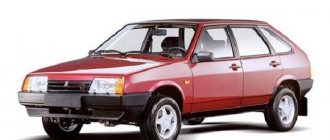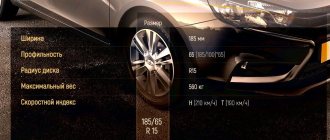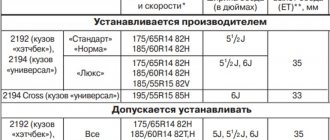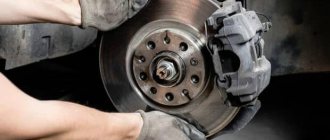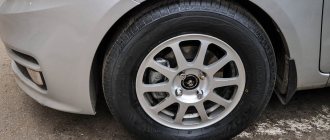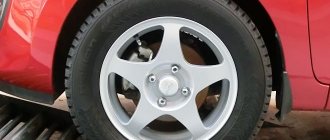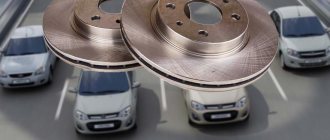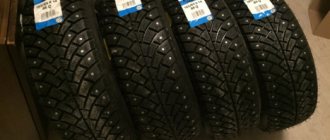After purchasing a car, the time comes when you need to change the rims on a Volkswagen Polo. In addition to the technical part of the issue, this is resorted to when there is a desire to update the car and make it more attractive on the road.
But it is worth noting that it is not always possible to correctly select the optimal disk sizes and their parameters. They will differ in standard and improved versions. If you don't choose the right one, problems can't be avoided.
Wheels for different versions of Volkswagen Polo
Various modifications of the Volkswagen Polo have their own sizes and characteristics. This applies not only to the specific model, but even to the year of manufacture. Manufacturers are trying to create the most favorable conditions for movement.
So, a liter Polo requires the installation of 13*4.0 wheels until 1994, after which 13*5.0 were installed. This made it possible to slightly reduce the disc offset from 38 to 35. This decision and the use of a certain tire size also had an impact. The rims on cars with a 1.2 engine remained virtually unchanged: 14*5.0 (6.0) or 15*6.0.
The FSI model with a 1.4-liter engine produced in 2007 requires the mandatory installation of 14*5.0 or 14*6.0 wheels. This also affects its offset and allows the use of completely different tires.
This suggests that not every Volkswagen Polo model can use the same wheel parameters. This issue should be approached with all responsibility, so as not to worry while driving on the roads.
When installing discs (casting) on the Trend version, you should use 5J*14 discs, which have an offset of 35. The Comfort version provides 6J*15, which has an offset corresponding to 38 mm.
Winter
Nokian Hakkapeliitta R3
Modern winter tire from a well-known manufacturer. Frequent winner of various competitions. It has excellent grip properties both on snowy roads and on ice.
A well-designed contact patch allows you to confidently maneuver at any speed. When maneuvering sharply, it does not skid and confidently clings to the road surface.
Advantages:
- excellent acceleration characteristics;
- high level of control;
- constant feedback;
- fuel economy;
- high adhesion properties.
Minuses:
- noisiness;
- mediocre braking on dry asphalt.
Continental ContiVikingContact5
Perfectly balanced tires for use in different modes. Suitable for use on both snowy and dry roads. Provides good grip properties both in urban environments and outside the city.
The steering feels full and sharp. Responsiveness allows you not only to control the movement of the car, but also to predict its further direction of movement.
Pros:
- confident acceleration dynamics;
- good braking performance;
- no skidding when maneuvering;
- holds tenaciously when rearranged;
- efficiency.
Minuses:
- hard;
- price.
Michelen X-Ice 2
They have advantageous characteristics both when braking on all types of winter roads (city, countryside, ice, snow, slush) and when accelerating. Not prone to slipping in snow drifts.
They allow you to correct the movement in time without additional effort using the steering wheel. The softness of movement preserves the suspension and allows the rubber to absorb impacts from holes and snowdrifts.
Pros:
- excellent braking;
- not prone to slipping;
- when rearranged, does not go into a skid;
- efficiency;
- soft.
Minuses:
- insufficient deceleration on dry asphalt.
Cordiant Polar SL
Representative of a more affordable line of tires. Handling characteristics are not balanced enough. Acceleration dynamics cannot please you either on a dry or snowy road.
On ice they are also prone to slipping. When maneuvering, they are delayed in their responses to steering wheel turns. They are noisy and harsh when going over bumps, as well as when driving on the highway.
Pros:
- price;
- directional stability on ice;
- strong side parts;
- high wear resistance.
Minuses:
- poor braking performance;
- tendency to slip at the start.
Standard wheels
In the standard version, the Volkswagen Polo sedan is equipped with “stampings” 5J-14, as well as 6J-15. In this case, 5 and 6 are the rim width, which is measured in inches on alloy wheels, J is the rim flange profile shape, and 14 and 15 are the rim diameter.
If you take a Polo in a Highline sedan body, it is marked with wheels 6J*15 ET 40 PCD 5*100. The correct location of the bolts is very important here, the distance between which must be maintained strictly at 100 mm. Disc offset (ET) is the distance to the plane of symmetry of the rim from its direct mounting. The unit of measurement used is millimeter. This is all provided for light alloy wheels.
The Volkswagen Polo is produced from the factory with an offset of 35 to 40 mm. In this case, the bolts are always located at a distance of 100 mm and are screwed in in the amount of 5 pieces.
The standard wheels will differ from each other in terms of bodywork. The parameters will be as follows:
- GF-6NAHW. All versions of the car produced in 2000 are equipped with wheels measuring 14*6.0 or 15*6.0. For this reason, the offset of the disk 43 and 45, respectively, will differ, which indicates the impossibility of using identical disks on different vehicles.
- ABA-9NBUD. If you take a car made in 1996, the wheels are 13*5.5 with an offset of 43. In 2007, 14*6.0 with a similar offset were installed on the car.
- GH-9NBBY. Wheel samples changed almost every year, as not only the size was adjusted from 14 to 16, but also the rim width from 6.0 to 6.5. But the offset and drilling remained unchanged.
- GH-9NBKY. In 2004-2007, the disks did not change and remained the same, namely 14 * 6.0. The only thing that is different is for the 2006 model. a rim diameter of 15 could be used, with all other identical parameters.
They use 5*100 drill bits almost everywhere. The only exception is the 2000 model GF-6NAHW body, which uses 4*100.
Engineers at the German car manufacturer do not rule out installing wheels with a diameter of R16 instead of standard ones. This is more focused on tuning and more on classic performance. But if the vehicle is purchased from a showroom, you can immediately forget about warranty service related to the chassis. That is, only the owner should decide this. This is called an experiment attempt, for which no one bears responsibility.
Tire table
| Tire radius (R value) | Width and height data (from what size) | Width and height data (up to what size) |
| R15 | 185/80 | 195/45 |
| R16 | 215/65 | 225/40 |
| R17 | 225/55 | 335/35 |
| R18 | 235/50 | 325/30 |
| R20 | 245/40 | 275/35 |
According to reviews on the Internet (both on foreign and domestic sites), car owners recommend pre-fitting them.
Mounting bolts
The fit of the bolts used on standard discs is spherical. They should be of the following type:
- Bolt cap for fixing the wheel – 3СО 601 173.
- Wheel security bolts included M14X1.5x27.5, 1KO 698 137A.
- WHT 001 812 is available for a single bolt of this size.
The correct bolt pattern guarantees a high-quality and long-lasting ride without consequences. You should be careful here, especially when installing non-standard wheels.
Disc selection
There is a huge range of wheels on the market that can be easily installed on a Volkswagen Polo car. They can be made of steel or casting. The dimensions are also different, which will fully depend on the car model, year of manufacture and other parameters.
Much will depend on the manufacturers, who have a slightly different approach to the process of creating wheels for cars, which affects the quality and duration of the operating period. Among them, the most popular manufacturers are:
- K&K. Most often, original discs of high quality are offered. Presented in a classic silver color, size p15*J6 ET 40. Russian production is also pleasant in price. The cost of one disc is approximately 3,500 - 4,000 rubles.
- Alutec.
- Le Mans.
- Milan.
- Sakura.
This all applies to the creators of alloy wheels, which bring great attractiveness to vehicles. But as mentioned earlier, you should not experiment, especially if you own a car from a dealership that is covered by warranty. The manufacturer Wolf has the best quality. But here it offers consumers even a diameter of R17 with J7.5. The price will vary between 5,000 – 6,000 rubles, depending on the place of purchase.
Cheaper options on the market are brands for the Volkswagen Polo sedan such as Akula, M33, CR-06, Kyoto, the cost of which starts from 2,500 - 3,000 rubles.
There is a purchase option for installing conventional “stampings”, the cost of which ranges from 1,000 – 1,500 rubles. Article numbers AR075, 7280T, X40028 and other options are usually used. Much depends on the diameter of the stamped disc and its other parameters, which are shown in the photo.
How to protect Volkswagen Polo wheels from theft
Not every car owner can keep his car in a garage or in a paid parking lot. Most residents of large cities are forced to leave their cars in unguarded places - in parking lots near their houses. Unfortunately, such vehicles are most at risk of theft or robbery. One effective way to protect your wheels from theft is to purchase security bolts.
Some secrets are sold together with plugs, which are difficult to remove without a special tool.
It is best to buy secrets of a complex shape that can be completely or partially drowned in a cast disk. It will be difficult to get to such a secret bolt with a key or chisel. Original security bolts, produced by VAG, with catalog number 5Q0698137, cost from 2,300 rubles. They fit all original wheels - both stamped and cast. Locks made in Germany by McGard, Heyner and ADL have proven themselves well.
Volkswagen Polo car owners, having read the above information, can choose the wheels and tires for their cars themselves. Among the huge number of offers, you should not pay attention to cheap products, since their quality and service life leave much to be desired. Properly selected, high-quality wheels determine not only the ride comfort, but also the controllability and safety of the vehicle in difficult weather conditions.
Non-standard disk parameters
You can do without standard wheels for the 2017 Volkswagen Polo. There are several options for replacement, which at the same time remain perfectly replaceable. The main thing is that the original bolts match the purchase exactly. Sometimes it happens that they are screwed into standard discs by 7-8 turns, but into new ones - only by 5-6 or something else. This indicates the need to look for another option or select a landing site. Sometimes even 28mm long cone bolts will come in handy.
It is best to choose from the ranges from 5J to 7J, having a radius from R14 and up to R17. Some craftsmen try to take even larger centimeters, which can lead to damage.
If the central hole of the disk differs from the classic 57.1 mm, special spacer rings should be used.
As for departure, in addition to the standard ET35-ET40, you can independently reach ET45.
